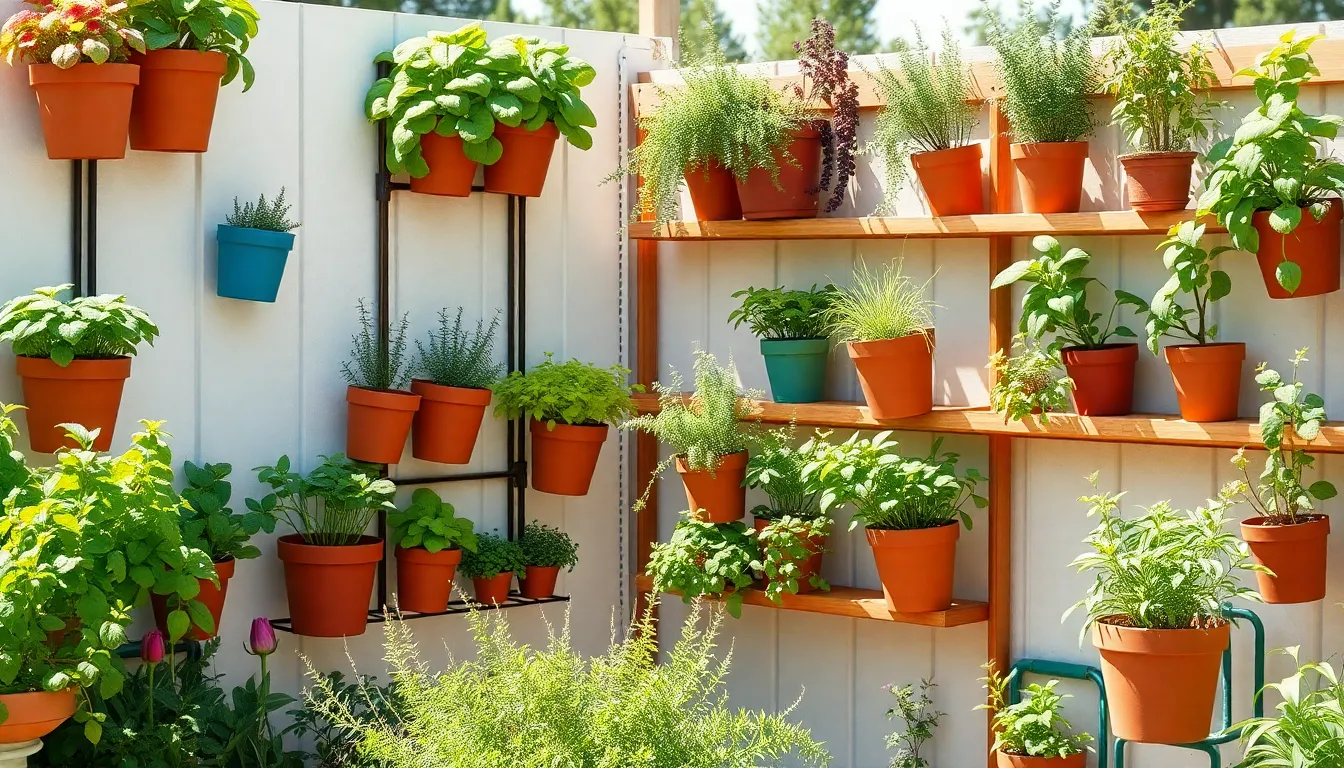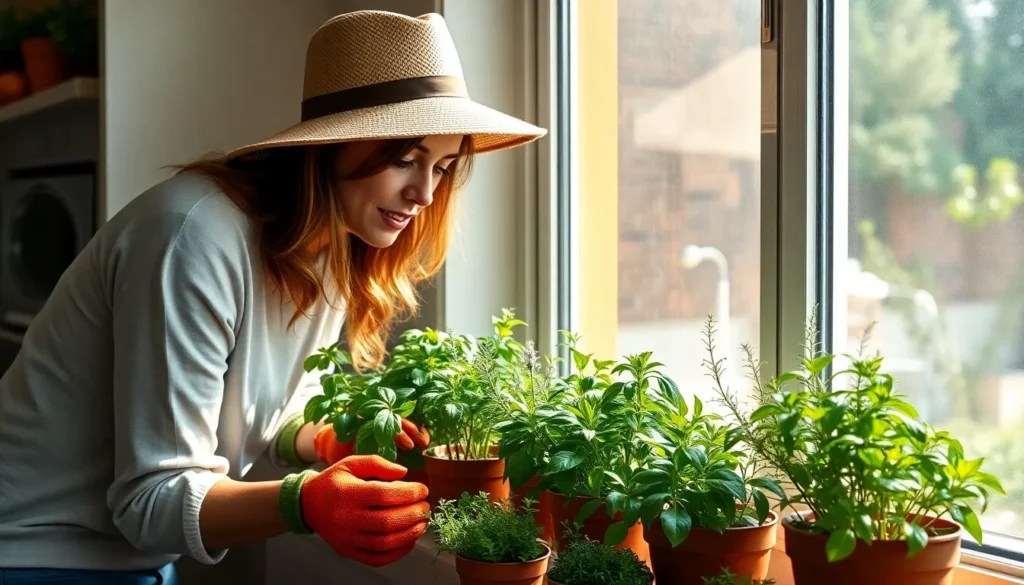Creating an herb garden is a delightful way to enhance culinary creations while adding greenery to any space. Whether it’s a sunny windowsill or a cozy backyard, growing herbs offers both beauty and practicality. Fresh herbs can elevate dishes and provide a fragrant escape right at home.
With a variety of herbs to choose from, the possibilities are endless. From classic basil and rosemary to exotic Thai basil and lemon verbena, each herb brings its unique flavor and aroma. Designing an herb garden can be as simple or as intricate as one desires, making it accessible for both novice gardeners and seasoned green thumbs alike. Embracing these herb garden ideas can transform any area into a lush, aromatic retreat.
Table of Contents
TogglePopular Herb Garden Ideas
Creating an herb garden offers diverse options that enhance both culinary practices and aesthetics. Here are popular ideas to consider for establishing indoor and outdoor herb gardens.
Indoor Herb Garden Ideas
- Windowsill Gardens: Utilize sunny windowsills to place small pots of herbs like basil, chives, and parsley. These herbs thrive with adequate sunlight and are easily accessible for culinary use.
- Hanging Planters: Implement vertical gardening concepts by using hanging planters for fresh herbs. This approach saves space and adds an attractive element to kitchens.
- Countertop Kits: Choose indoor herb garden kits designed for easy setup. Many kits include growth lights and self-watering features, simplifying the cultivation process.
- Herb Towers: Construct tiered herb towers to maximize vertical space. These towers accommodate various herbs simultaneously and create a striking visual display.
Outdoor Herb Garden Ideas
- Raised Beds: Build raised garden beds for a structured approach to herb gardening. These beds enhance drainage, protect plants from pests, and provide easy access for maintenance.
- Herb Spiral: Design a herb spiral that creates microclimates, optimizing growth for different herbs. This method encourages biodiversity and conserves water efficiently.
- Container Gardens: Use large containers or pots to create movable herb gardens. This flexibility allows for creative arrangements on patios, balconies, or porches.
- Border Gardens: Incorporate herbs as borders along pathways or garden edges. Plants like lavender and sage serve decorative purposes while also providing culinary benefits.
Creative Containers for Herb Gardens

Exploring unique container options enhances the versatility and visual appeal of herb gardens. Creative containers not only optimize space but also reflect personal style.
Vertical Gardening Solutions
Utilizing vertical gardening solutions maximizes limited space and creates an eye-catching display. Ideas include:
- Wall-mounted Planters: These attach directly to walls, providing a striking vertical garden. They work well for small herbs like thyme or mint.
- Hanging Containers: Hanging pots from ceilings or hooks adds depth and dimension. Use them for cascading herbs like oregano or trailing basil varieties.
- Tiered Shelves: Stacked shelving units allow herb access at varying heights, making them an attractive and functional choice. Perfect for organizing herbs like parsley and cilantro.
Raised Beds and Planters
- Wooden Raised Beds: Durable and customizable, these beds can accommodate numerous herbs and create a rustic look. They suit larger herbs like rosemary and sage.
- Ceramic or Terracotta Planters: These materials provide excellent insulation for roots while adding aesthetic appeal to gardens. Ideal for heat-loving herbs such as basil and thyme.
- Recycled Containers: Repurposed materials like old crates or buckets can yield a unique garden style. They suit various herb types, from chives to dill, promoting sustainability while being aesthetically pleasing.
Companion Planting with Herbs
Companion planting with herbs enhances garden health and maximizes space. This practice involves planting certain herbs alongside vegetables and other plants to promote growth, deter pests, and increase overall yields.
Benefits of Companion Planting
- Pest Control: Herbs like basil repel pests such as aphids and mosquitoes. Similarly, mint deters unwanted insects, providing a natural barrier for nearby plants.
- Disease Prevention: Planting herbs such as rosemary can help guard against fungal infections, protecting more vulnerable plants in the garden.
- Improved Growth: Some herbs release compounds that benefit neighboring plants. For example, parsley promotes the growth of tomatoes.
- Biodiversity: Incorporating various herbs fosters a balanced ecosystem, attracting beneficial insects like pollinators and predatory species that control pests.
Best Herb Combinations
- Basil and Tomatoes: Basil enhances tomato flavor while repelling whiteflies.
- Rosemary and Cabbage: Rosemary wards off cabbage moths, benefiting cabbage growth and health.
- Mint and Peas: Mint enhances the growth of peas and deters aphids, creating a thriving environment.
- Chives and Carrots: Chives improve carrot growth while repelling carrot flies, ensuring a more productive harvest.
- Sage and Broccoli: Sage deters pests that target broccoli while improving its flavor profile.
Utilizing the right herb combinations leverages companion planting to create flourishing gardens.
Seasonal Herb Gardening Tips
Seasonal care enhances the success of an herb garden. Understanding planting and maintenance specifics ensures robust growth throughout the year.
Spring Herb Planting
Spring marks the ideal time for planting herbs. Five essential herbs thrive in spring: basil, cilantro, chives, dill, and parsley.
- Basil: Plant basil after the last frost in well-drained soil, ensuring full sunlight for optimal growth.
- Cilantro: Sow cilantro seeds directly in the garden, choosing a location with ample sunlight and consistent moisture.
- Chives: Divide established chive plants or sow seeds directly in spring; they adapt well to various soil types.
- Dill: Plant dill seeds in a sunny area; this herb prefers light, well-drained soil and regular watering.
- Parsley: Start parsley seeds indoors for early growth or sow them directly outdoors as temperatures warm.
Proper spacing among plants enhances air circulation, preventing diseases. Mulch helps retain soil moisture and suppress weeds.
Fall and Winter Herb Care
Fall and winter present unique challenges for herb cultivation. Five strategies ensure herb survival through colder months: harvesting, mulching, indoor relocation, frost protection, and pruning.
- Harvesting: Regularly harvest herbs before frost sets in, promoting healthier growth and flavor concentration.
- Mulching: Apply a layer of organic mulch to protect roots from cold temperatures and reduce weed growth during winter.
- Indoor Relocation: For tender herbs, transfer pots indoors before heavy frosts. Place them in bright, sunny windows for consistent light exposure.
- Frost Protection: Use row covers or frost cloths to shield outdoor herbs from severe cold and preserve their growth potential.
- Pruning: Trim dead or damaged foliage from herb plants to promote healthier growth and prevent disease throughout winter.
Implementing these seasonal strategies supports thriving herb gardens year-round.
Creating an herb garden is a rewarding endeavor that enriches both the home and the culinary experience. With a wide variety of herbs to choose from and numerous creative gardening methods available, anyone can find a suitable approach that fits their lifestyle and space. Whether opting for a compact indoor setup or a vibrant outdoor garden, the possibilities are endless. Embracing companion planting and seasonal care strategies ensures a thriving herb garden throughout the year. By cultivating fresh herbs, individuals not only enhance their dishes but also foster a deeper connection with nature. It’s time to get started and enjoy the many benefits that an herb garden brings.



